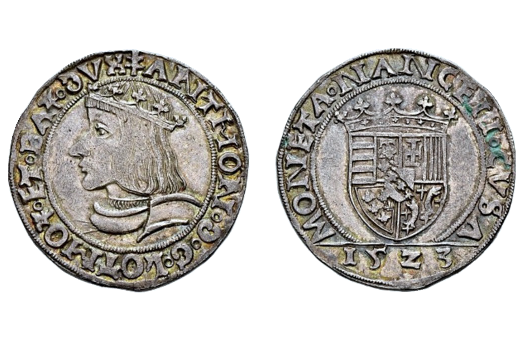
about ancient nomos
Ancient Nomos Art is a museum of galleries exhibiting ancient coins and ancient mint maps. The coin gallery displays the diverse art and history of hand-crafted ancient Greek, Roman, Byzantine, Persian and Medieval coinage. The ancient mints mapping gallery features Greek, Roman, Byzantine, Asia Minor and Medieval mint city regions and territories. Visitor's are welcome to explore, study and enjoy Ancient Nomos Art.

Post-Medieval France – 1523 AD
Antoine as Duke
From Ancient Galleries

Obverse: Legend: +ANTHON ᵒ ∂ ᵒ G ᵒ LOTMOЧ ᵒ ET ᵒ BAЧ ᵒ ∂VX, crowned bust of Duke Antoine facing left.
Reverse: Legend: MONETA ᵒ NANCEII ᵒ CVSA, crowned ducal coat-of-arms; date 1523 in exergue.
LEGENDS
Obv: +ANTHON ᵒ ∂ ᵒ G ᵒ LOTMOЧ ᵒ ET ᵒ BAЧ ᵒ ∂VX, crowned bust of Antoine facing left. Rev: MONETA ᵒ NANCEII ᵒ CVSA, crowned ducal coat-of-arms; date 1523 in exergue.
This piece is a delightfully choice hammered provincial teston issued by the French Duke Antoine, circa 1523 AD. The piece is an exceptional early example of Renaissance style coinage featuring a solid strike, alluring cabinet tone & lovely iridescent hints. The French provincial Duke Antoine “Le Bon” (known as ‘the Good’), was Duke of Lorraine from 1508 AD until his death in 1544 AD. Antoine was born, 4 June 1489, at Bar-le-Duc, the son of René II, Duke of Lorraine and Philippa of Guelders. He spent seven years at the court of King Louis XII together with his brother Claude, and became friends with the Duke of Angoulême, the future King Francis I. After the death of his father, Antoine succeeded him as duke of Lorraine in December 1508. Antoine would later engage twice in campaigns in Italy: once under Louis XII and the other with Francis I. During the German Peasants’ War, he would defeat two armies while retaking Saverne and Sélestat. Antoine succeeded in freeing Lorraine from the Holy Roman Empire with the Treaty of Nuremberg of 1542. In 1544, while Antoine suffered from an illness, the Duchy of Lorraine was invaded by Emperor Charles V’s army on their way to attack France. Fleeing the Imperial armies, Antoine was taken to Bar-le-Duc where he died on June 14, 1544. The early 16th century teston coins are some of the first post-medieval era to reflect a new style and iconography, which began to appear at the beginning of the Renaissance. Medieval silver coins in Europe, prior to these post-medieval testons (first struck in Italian and French Feudal states), did not have realistic portraits of rulers, only legends and symbols. Placing a realistic Renaissance style portrait of a duke or ruler on the obverse marked an artistic change in style which rapidly spread across Europe.
DOCUMENTATION
Value: Teston. Metal: AR Silver. Weight: 9.51 grams. Mint: Nancy mint. Date: 1523 AD.
Attribution: Flon 18; De Saulcy XV, 16 var. (date); Roberts 9552 var. (same); E. Boudeau, Monnaies Françaises Provinciales, 1514; Künker 127, 4874; Ex. Annemarie und Gerd Köhlmoos Collection Numismatic Rarities and Masterpieces, 1134 (this coin).
Legend, Documentation and Attribution
